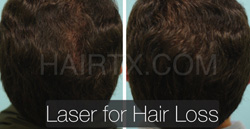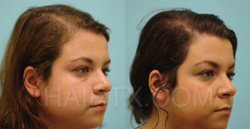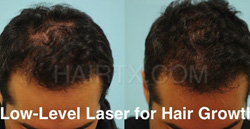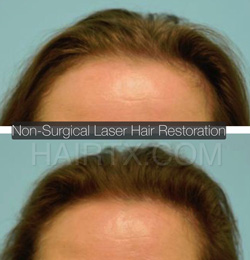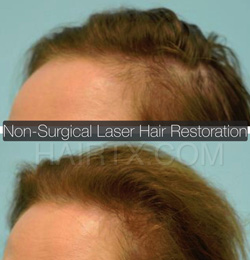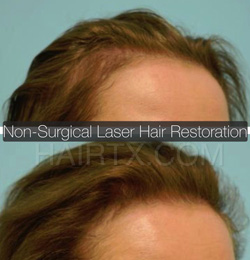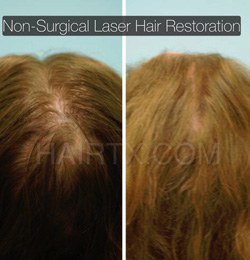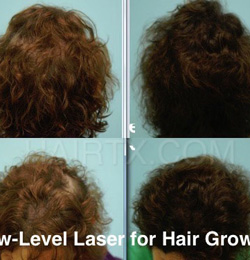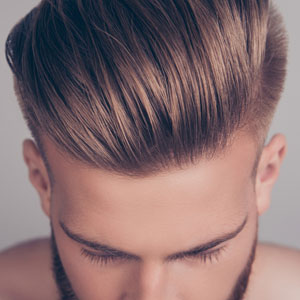Low-Level Laser Therapy (LLLT)
In the past, LLLT required a patient to come to the office to sit under a laser device multiple times a week. These inconvenient visits would ultimately lead to failure to achieve any significant results because it was impossible to be reasonably compliant with these regular visits. In addition, these devices were technologically inferior to what can be offered today with home-unit devices that provide a far easier and more cost-effective long-term solution. The device Dr. Lam recommends can be hidden under a standard baseball cap and should be worn approximately 20 minutes 3 times a week to achieve the desired hair growth results.
Contact Us Today! Read Our Manifesto Visit Our Gallery
In fact, you can be conducting your daily affairs easily while wearing the laser cap. For example, you can be driving, cooking, watching television, reading in bed, or even walking without being obvious that you are wearing a laser device. Dr. Lam sells both wired (with a cable to a portable battery pack) and wireless (battery pack hidden within the device) versions and can discuss with you which device may be better for you.
Understanding Laser Light Therapy
Laser therapy is effective in both men and women with no real side effects. Since LLLT works through a different pathway to restore lost hair, it can complement other therapies, such as minoxidil and/or finasteride or it can be an effective standalone method to combat hair loss. It should be remembered that these types of therapies are intended only for cases where the hair is thinning or miniaturizing.
Once hair is completely gone, the laser will be generally less effective. In these cases, surgery is the preferred method for hair restoration. However, like other medical therapies, LLLT can be used alongside surgery: hair-transplant surgery can restore lost hair and LLLT can be used to reverse thin or miniaturized hair. In addition, LLLT can be restarted the day after surgery to help improve surgical graft growth, both for consistency and speed of results. If someone is contemplating a surgical hair transplant, Dr. Lam advises to consider starting before surgery and quickly resuming LLLT after the procedure.
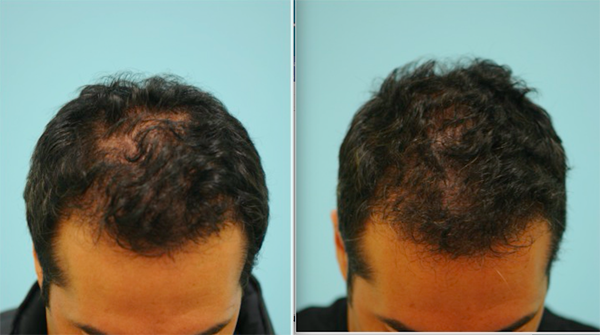
This male patient is shown before and after just a few months of low-level laser therapy (LLLT) with notable reduction of his hair loss.

This female patient is shown before and after just a few months of low-level laser therapy (LLLT) with improvement in her central density and hairline.
Types of Laser Light Therapy
There are many LLLT devices on the market today but most of them have shortcomings that Dr. Lam believes will compromise your results. For example, comb devices suffer from the need to constantly brush them through the scalp that can be tiring and thereby result in less compliance. Further, these devices do not evenly distribute laser therapy to the entire scalp in a uniform and sustained manner.
Some laser models do not offer true laser therapy but only light therapy that has been shown to be far less effective than controlled lasers. Dr. Lam only offers the very best technology available on the market and does so far below retail prices to encourage every patient with hair loss to start and maintain laser therapy if possible. After a detailed consultation with Dr. Lam and his team will see whether LLLT is the right choice for you.
LLLT has its role in treating hair loss but Dallas hair transplant surgeon Dr. Sam Lam uses LLLT as an ancillary method, which helps patients but not as effectively as other therapies like Folliflo, Hair Stem, and of course other types of biochemical therapies. Only after a consultation with Dr. Lam will he be able to guide you on the most effective therapies.
Key Points
- Ideal candidate
- Male and Female at early stages of hair loss
- Someone whose hair is not growing as long or as dense as in youth
- Someone who has been on other types of medical therapies, e.g., minoxidil, and is looking for other ways to stimulate hair growth
- What to do
- Use it 3 times a week for 20 to 30 minutes each time, e.g., Monday, Wednesday, and Friday. Do not use it every day or any two consecutive days: doing so can lead to hair loss through over-stimulation of the follicle.
- You can use it before or after minoxidil application.
- Part your hair to expose your scalp as much as possible for the laser to work better since it stimulates the base of the follicle at the level of the scalp.
- If you are using hair fibers, make sure to wipe them off completely before you use the laser.
- What to expect
- The results can be observed as early as 4 months after starting treatment. We will take before-and-after photos to monitor your progress.
- The improvement can continue up to 12 months from starting the treatment and thereafter reach a plateau.
- Rarely some patients can experience hair shedding at the beginning of the treatment around 4 to 8 weeks after starting. This is temporary and should subside.
Contact Our Office
Dr. Sam Lam proudly provides low-level laser light to men and women experiencing mild to moderate hair loss in Dallas, TX. If you’re interested in learning more about it, contact our office to schedule your initial consultation today.
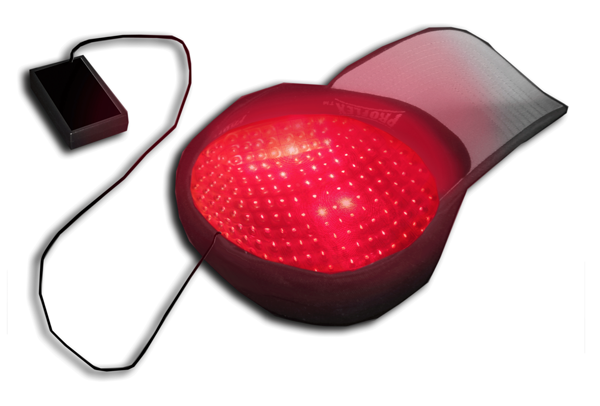
This photo shows the type of laser device that Dr. Lam believes provides the most uniform and favorable results in patients who are losing hair. Low-level laser therapy (LLLT) can be effectively combined with surgery or other medical therapies for optimal reversal of many hair-loss conditions.
Wired LLLT device shown here The way that LLLT works is that the device emits a cold laser light that is very safe in the wavelength of 600 to 650 nm used to trigger the hair to start growing. LLLT is now FDA approved and clinically shown in multi-institutional, double blind, quantitative, and qualitative studies to be effective in promoting hair growth and reducing hair loss. Once the unit is purchased, it can offer a lifetime of ongoing therapy.
FAQs
-
Do lasers really work?In short, yes. Large-scale studies have proven the effectiveness of this technology in every subset of the population divided by ethnicity, age, and gender across multi-institutions that reviewed LLLT both blindly and prospectively with sham-device controls. Dr. Lam has been using lasers on his patients and following the results carefully and have found them to work very well even as a standalone therapy. These new lasers are far more powerful than the old-generation lasers that were floor-standing models that you had to drive to the office to use.
-
Are lasers safe?Yes. Lasers are simply low-level light therapy applied to the scalp hair to stimulate growth. There are practically no known side effects with this technology and can be used safely for many months to years.
-
How do lasers really work?The technical side is that LLLT acts by stimulating the intracellular pathway NF-kB that impacts cellular proliferation. In addition, LLLT induces intracellular reactive oxygen species (ROS), which can also play a part in the NF-kB signaling pathway, and reduce cellular apoptosis (cell death). Further, another mitochondrial pathway has been shown to be activated, cytochrome C oxidase, that stimulates hair growth.These pathways have also been extensively investigated in animal models.
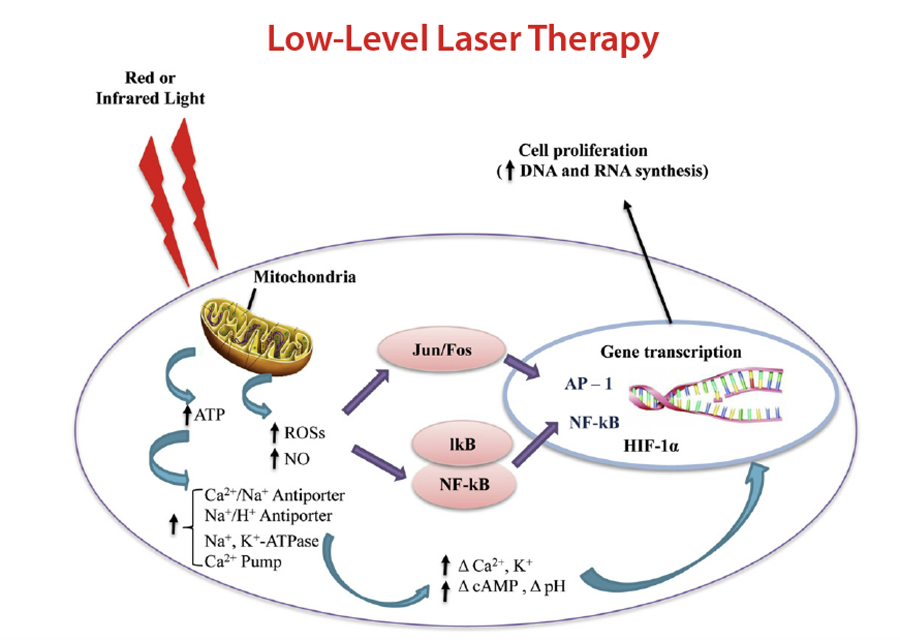
-
Are all the laser devices the same on the market?No. There are many inexpensive laser devices being sold, but they lack a few of the key benefits that Dr. Lam’s model has incorporated. First, many of these models do not use lasers but instead incoherent light, which is far cheaper and has been shown not to work in hair growth. Second, many of the models have far fewer laser points of emission so that the entire scalp is not uniformly covered. Third, the laser energies have not been properly calibrated for the fluence (energy) delivery for hair growth. Fourth, some of the hair comb devices are tedious and hard to comply; and they do not allowuniform scalp delivery.
-
I have heard after a year that I do not need to continue using it?This is a conjecture that Dr. Lam does not have enough clinical experience to justify. However, you could slow down the use of the device after the first year to see if your hair growth remains stable.
-
I can’t decide between purchasing a laser versus PRP or some other therapy for hair loss?What should I do? This is a hard question to answer. It depends on a lot of factors: your gender, your compliance, your initial versus ongoing budget, your side-effect profile that you are willing to accept, etc. Dr. Lam needs to evaluate you in person to help you make this determination.
 Lam Institute For Hair Restoration
Lam Institute For Hair RestorationVideos
Photos
For more Laser Therapy Before & After Photos, Click here

